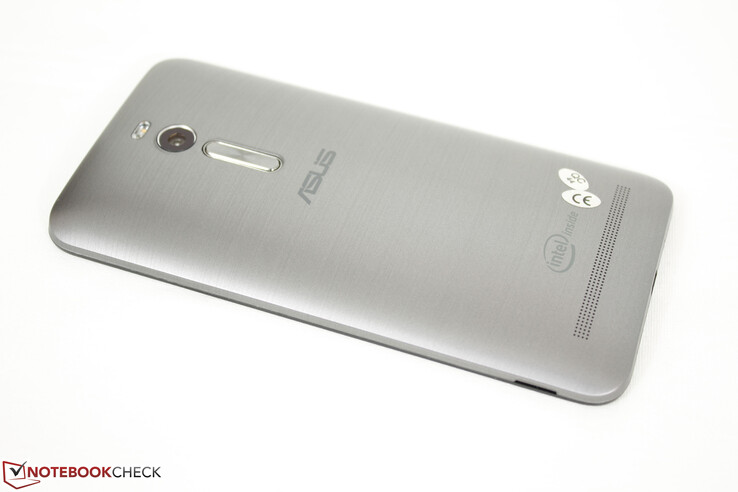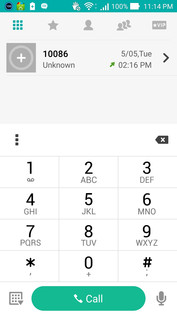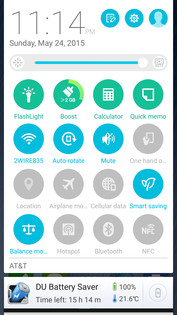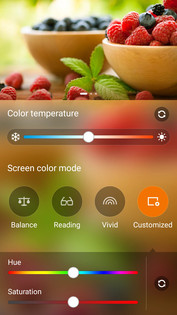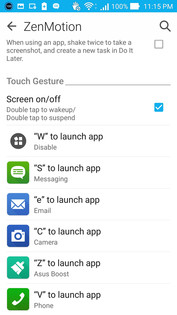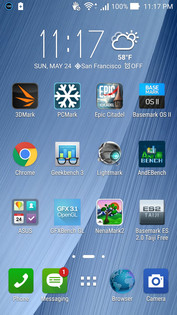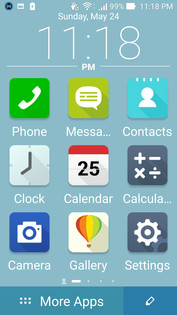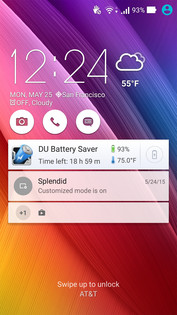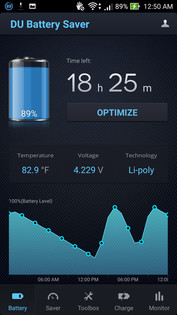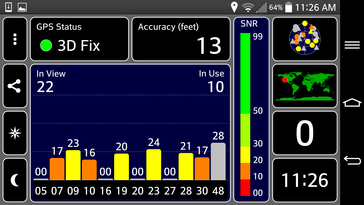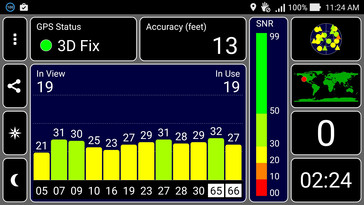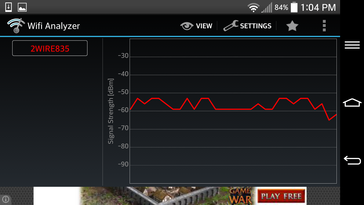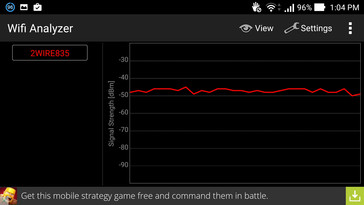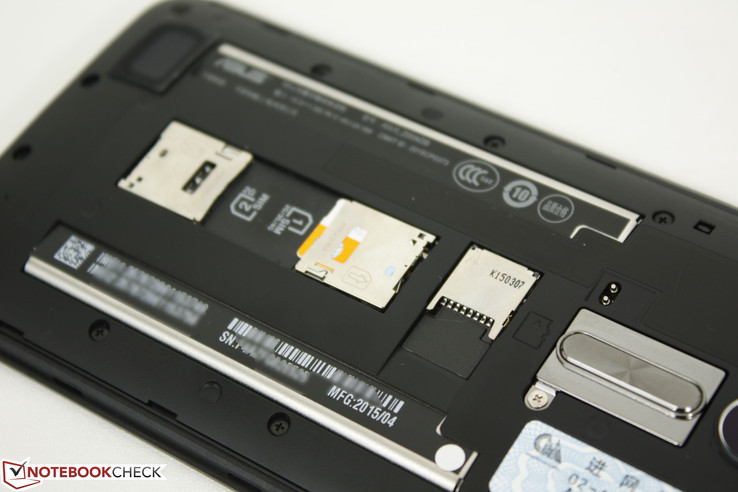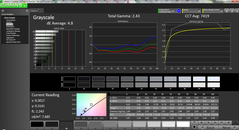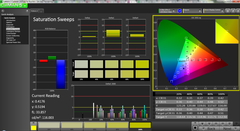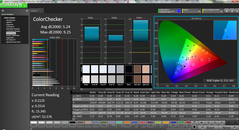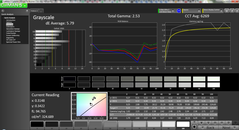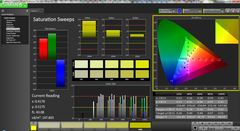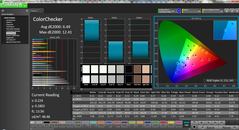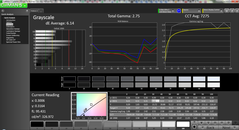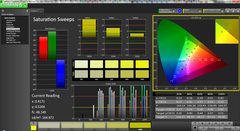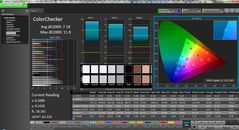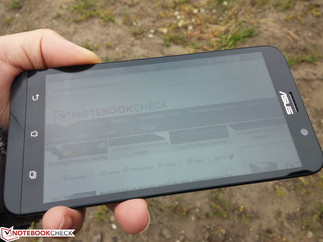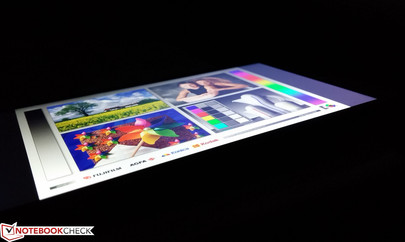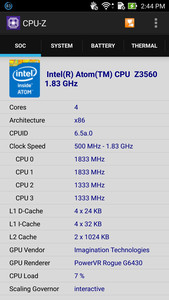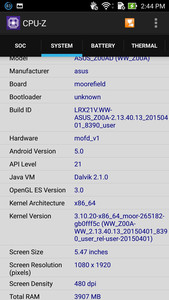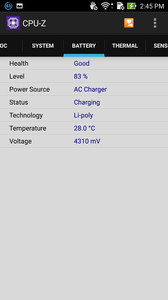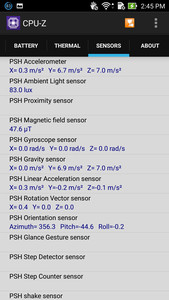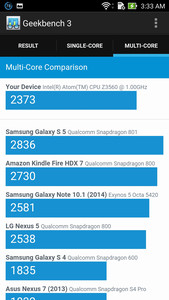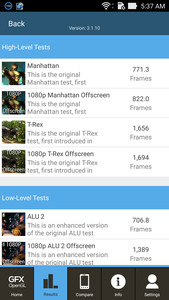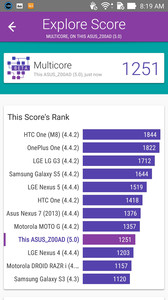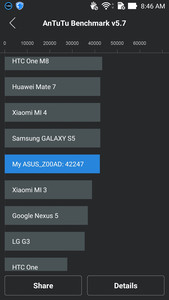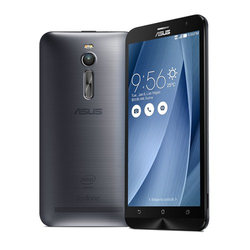Asus ZenFone 2 Smartphone Review

Test model provided by GearBest.com. The 4 GB Gray model is currently available for $275 with coupon code ASZ4GB.
Asus hit an early home run in the tablet space with the impressive Transformer and MeMo series that eventually won them contracts to produce the first Nexus tablets for Google. Now the manufacturer is trying everything it can to replicate that success in the crowded smartphone space and things are off to a good start -- the ZenFone series has already won the Red Dot Design Award 2015 for best product design.
The ZenFone 2 begins where the 5-inch ZenFone 5 and 6-inch ZenFone 6 left off by offering a 5.5-inch display with high-end specs that sit comfortably between mainstream and flagship phones. The 1080p display and dual-SIM slots are old hat for an international phone, but the ZenFone 2 throws a curve ball with an Intel Atom CPU and a ridiculous 4 GB RAM for a retail price of $300 to $350. A more down-to-Earth configuration with 2 GB and a 5-inch 720p display is also available in the $200 range. Let's see how the leading confguration holds up against the competition.
Case
Asus calls the ZenFone 2 "... the best looking smartphone, ever." As subjective as that may be, it's hard to argue against the attractive brushed metallic look of the back cover, especially in those inevitable macro shots of the device. The curved back only accentuates the reflections and shares visual similarities to the costlier LG G3 and HTC One M9. Meanwhile, the front face is the usual Gorilla Glass glossy fare with a 72 percent screen-to-body ratio and more brushed metallic texture work on the bottom for good measure. Users who have had hands-on time with the ZenFone 5 or ZenFone 6 will know exactly what to expect here as the overall design philosophy and appearance remain largely unchanged. The notable exception is the Volume rocker, which is now on the back of the device a la the LG G2 and G3.
Unfortunately, "metallic look" in this case is just a fancy way of saying "plastic" or "polycarbonate". When removed, the back cover bends and twists as easily as any other plastic cover and is not a true aluminum alloy as are the covers on the HTC One M8 and M9. Edges and corners feel soft and will ding more easily than alloyed smartphones. With that said, the ZenFone 2 is still rigid with no creaking or visible depressions and only minimal twisting overall. As is a common feature with removable back covers, multiple colors are available for added customization.
Its arched back gives the ZenFone 2 a maximum thickness of almost 11 mm (or 3.9 mm around the thin edges), which is thicker than all other 5.5-inch smartphones in our comparison graphic below. Weight is luckily in line with what we expect from a device this size at about 170 g compared to the iPhone 6 Plus (172 g), OnePlus One (164 g), and LG G Flex 2 (152 g).
Connectivity
Physical connectivity ports include the usual USB 2.0 on bottom and 3.5 mm audio on top. As with most Android devices since Honeycomb, USB OTG is supported and we were able to connect generic mice and and keyboards without issues. We also tried a MHL USB-HDMI adapter on the off-chance that it may work, but to no success.
Software
ZenUI is the exclusive front-end interface for most smartphones and tablets from Asus. It's not as far-reaching as the recent Sense makeover from HTC and is actually quite light in terms of custom settings and animations, but it does add a couple of useful features. In particular, ZenMotion makes it quick to open any preset application without needing to wake the display by drawing a letter or command on the blank screen, while Easy Mode is perfect for entry-level users who have no need for extra features and prefer fewer and larger icons. Finally, ZenLink encompasses both remote PC and local connections through WiFi or Bluetooth.
The overall feel is otherwise Android 5.0 at its core with minimal fluff. There is of course the wave of pre-loaded apps as expected from any Android software suite.
Communication & GPS
Wireless connections include 802.11ac with Bluetooth 4.0, NFC, and Miracast (via the PlayTo function). We experienced no dropout or limited range issues when connected to a standard WLAN network. Compared to a LG G2, the Asus shows slightly better signal strength and consistent connection under the same network and conditions.
The built-in GPS works as expected with a faster TTFF compared to the LG G2. It is also able to take advantage of more satellites in view, which should lower the chances of signal loss during use.
Telephone & Speech Quality
Compatible bands are wide and varied and too great to list here -- we refer to the official Asus specifications for the full list of 2G, 3G, and 4G bands. The bottom line for U.S. users is that the ZenFone 2 will work with the two biggest GSM carriers: AT&T and T-Mobile. Verizon, Sprint, and other CDMA carriers are not officially supported. We were able to use both 3G and 4G with our own AT&T and T-Mobile SIM cards.
Since the battery is non-removable, both Micro SIM slots are accessible without needing to power down the device. However, Asus makes it very clear that only one slot supports 2G, 3G, and 4G bands, while the second slot supports up to 2G.
Call quality with full bars sounds good from both ends. Our LG G2 receiver on the other end is able to hear very clearly with no breaks, though voices carry more static to the listener on the ZenFone 2. Fortunately, it's not enough to significantly impact user experience. Reception is largely not an issue, at least with AT&T in San Francisco.
Cameras
The rear 13 MP (4096 x 3072) camera uses the standard f/2.0 aperture that most other smartphones have with the usual ISO (50 to 800), auto-focus, HDR, and face detection features. There is also a full Manual mode to mimic DSLR features, though this setup offers little more than the default camera mode. Certain 2 GB ZenFone 2 models will only have 2 MP and 8 MP front- and rear-facing cameras, respectively, compared to 5 MP and 13 MP Toshiba sensors on our higher-end configuration.
Camera quality is good in terms of colors with no hints of purple fringing when used outdoors. Instead, sharpness is the issue as the ZenFone is unable to accurately capture hard corners and edges of objects as well as competing cameraphones. Smaller details and textures of surfaces will be comparatively more blurred.
Low Light Mode reduces captured images to 3 MP and increases shutter time. Flash is disabled in this mode and while this does significantly improve natural lighting for a picture, overall quality becomes much more washed out as opposed to just using the standard Flash. In fact, the built-in Flash is powerful enough for low-distance shooting and is the preferable option.
Video recording supports up to 1080p30 and files are saved as MP4 with a content bit rate of about 15000 kb/s. Similar to snapshots taken with the ZenFone 2, video quality could be more crisp with less blurring when panning. In other words, the Asus brings nothing special here.
Accessories & Warranty
The box includes the standard Quick Start guide, Micro-USB charger, and power adapter. Users aren't treated to any neat extras like screen protectors, earphones, or additional back covers. Instead, Asus offers these as optional accessories including Flash and selfie add-ons designed specifically for the ZenFone.
Asus warranty is the standard 12-month period from date of purchase. The manufacturer does not cover dead pixels and does not offer extended warranty options by registering the device.
Input Devices & Interface
It's unfortuante how so many inexpensive smartphones can implement touchscreen responsiveness and latency so poorly. Inaccurate inputs, lag for fast typists, and missed keys are enough to ruin even the best-looking devices. This is fortunately not the case for the ZenFone 2 as inputs are registered just as fast as we can humanly type on the included virtual keyboard. The touchscreen is as responsive and precise around the edges and corners as it is on the center, which is not something we can say for all phones.
As for the onscreen keyboard, it is the same one included with the ZenFone 5 and ZenFone 6. Users have all the standard options such as word prediction, Swype-like functionality, and keyboard height adjustments. Users may want to tone down the latter as the default keyboard height is a bit too high to comfortably read SMS texts.
Also of note are the dedicated Back, Home, and Tabs buttons common amongst Android devices. This frees up valuable onscreen real-estate at the cost of a larger bezel. This is perhaps best exemplified by the noticeable discrepancy in length between the 5.5-inch LG G3 and ZenFone 2 (74.6 mm vs. 77.2 mm).
Display
Needless to say, the 5.5-inch 1080p display is spectacular and easier on the eyes compared to smaller 5-inch 1080p models. Images and texts are crisp on their own right, but certainly not as sharp as the increasingly common 1440p displays on flagship phones like the G3 or Galaxy S6. The screen itself is also under a seemingly thicker layer of glass, so colors do not pop as much as they would on an iPhone 6 Plus.
Measured black levels are low for a very good contrast of about 1000:1, which is comparable to competing models. Screen brightness is the low point of the device at an average of just over 300 nits compared to over 400 nits on other major 5.5-inch models. While not bad and certainly sufficient for indoor use, this makes the ZenFone a poorer choice for outdoor use.
| |||||||||||||||||||||||||
Brightness Distribution: 89 %
Center on Battery: 329.4 cd/m²
Contrast: 1105:1 (Black: 0.298 cd/m²)
ΔE Color 5.24 | 0.5-29.43 Ø5
ΔE Greyscale 4.8 | 0.57-98 Ø5.3
Gamma: 2.43
| Asus Zenfone 2 ZE551ML | Apple iPhone 6 Plus | OnePlus One | LG G Flex 2 | Xiaomi Redmi Note 4G | LG G3 | |
|---|---|---|---|---|---|---|
| Screen | 5% | -17% | -23% | -4% | -37% | |
| Brightness middle | 329.4 | 519 58% | 423 28% | 278 -16% | 446 35% | 417 27% |
| Brightness | 315 | 496 57% | 408 30% | 274 -13% | 418 33% | 395 25% |
| Brightness Distribution | 89 | 90 1% | 83 -7% | 97 9% | 87 -2% | 89 0% |
| Black Level * | 0.298 | 0.62 -108% | 0.54 -81% | 0.47 -58% | 0.96 -222% | |
| Contrast | 1105 | 837 -24% | 783 -29% | 949 -14% | 434 -61% | |
| Colorchecker dE 2000 * | 5.24 | 3.67 30% | 5.56 -6% | 8.03 -53% | 5.1 3% | 5.67 -8% |
| Greyscale dE 2000 * | 4.8 | 3.78 21% | 7.55 -57% | 6.71 -40% | 5.93 -24% | 5.66 -18% |
| Gamma | 2.43 91% | 2.42 91% | 2.33 94% | 1.89 116% | 3.46 64% | 2.53 87% |
| CCT | 7419 88% | 7327 89% | 7624 85% | 7750 84% | 7350 88% | 7741 84% |
| Color Space (Percent of AdobeRGB 1998) | 59 |
* ... smaller is better
Color analyses with a spectrophotometer reveal generally accurate colors across all tested saturation levels. Colors do not become increasingly less accurate with increasing or decreasing saturation. The screen also avoids an overly blue temperature that commonly plagues cheaper phones.
Of particular note is that the ZenFone 2 offers four different color modes: Balance, Reading, Vivid, and Customized. As shown in our measurements below, Balance offers the most accurate colors against the sRGB standard. Reading mode will drop correlated color temperature from around 7K to 6K for a warmer picture, while Vivid mode brightens colors at the cost of accuracy. Lastly, the Customized mode allows users to manually change the Hue and Saturation at will.
Outdoor usability is acceptable, but the maximum brightness setting is essentially required as the backlight is weaker than on competing models. Shade or overcast days are best as using the ZenFone 2 under direct sunlight for extended periods will become uncomfortable.
It is also recommended to disable the Asus Smart Battery feature when outdoors. Otherwise, maximum display brightness will be limited to just 160 nits.
Performance
Asus equips the ZenFone 2 with not one, or two, but three different Intel Atom processors to choose from. The lowest configuration uses the dual-core 1.6 GHz Atom Z2560 with weaker PowerVR SGX544MP2 graphics, while the middle and high-end configurations are equipped with a quad-core 1.8 GHz Atom Z3560 and 2.3 GHz Atom Z3580, respectively. Our in-house model uses the more mainstream Atom Z3560, which is the same processor as found on the FonePad 7 and a number of MeMo tablets from Asus.
General system performance is very fast with little lag time when multi-tasking between applications. Raw CPU performance is just a step below the high-end Snapdragon 800 series found on flagship smartphones. According to CPU-Z, the Z3560 in our ZenFone 2 can operate up to its rated 1.83 GHz for all cores simultaneously, though this is rare as all cores will normally operate in the 500 to 1333 MHz range for most tasks. No cores here are ever disabled when the display is on and active.
The 4 GB RAM allows for an insane number of simultaneous applications. CPU-Z records about 2.4 GB of free RAM when no other applications are running, and this is including all the default adware and background applications that may be active. Asus claims about 1.5x faster multi-tasking performance compared to 2 GB smartphones when at least 26 applications are running. Most users may never feel a difference, but users who don't periodically manage the inevitable buildup of junk applications may benefit from the additional headroom.
| PCMark for Android - Work performance score (sort by value) | |
| Asus Zenfone 2 ZE551ML | |
| Asus Fonepad Note FHD 6 ME560CG (K00G) | |
| OnePlus One | |
| HTC One M9 | |
| Google Nexus 9 | |
| Google V8 Ver. 7 - Google V8 Ver. 7 Score (sort by value) | |
| Asus Zenfone 2 ZE551ML | |
| Asus Fonepad Note FHD 6 ME560CG (K00G) | |
| OnePlus One | |
| HTC One M9 | |
| Apple iPhone 6 Plus | |
| Google Nexus 9 | |
| Octane V2 - Total Score (sort by value) | |
| Asus Zenfone 2 ZE551ML | |
| HTC One M9 | |
| Apple iPhone 6 Plus | |
| Google Nexus 9 | |
| Mozilla Kraken 1.1 - Total (sort by value) | |
| Asus Zenfone 2 ZE551ML | |
| Asus Fonepad Note FHD 6 ME560CG (K00G) | |
| OnePlus One | |
| HTC One M9 | |
| Apple iPhone 6 Plus | |
| Google Nexus 9 | |
| WebXPRT 2015 - Overall (sort by value) | |
| Asus Zenfone 2 ZE551ML | |
| HTC One M9 | |
| Peacekeeper - --- (sort by value) | |
| Asus Zenfone 2 ZE551ML | |
| Asus Fonepad Note FHD 6 ME560CG (K00G) | |
| OnePlus One | |
| HTC One M9 | |
| Apple iPhone 6 Plus | |
| Google Nexus 9 | |
| ANDEBench PRO | |
| 3D (sort by value) | |
| Asus Zenfone 2 ZE551ML | |
| OnePlus One | |
| HTC One M9 | |
| Platform (sort by value) | |
| Asus Zenfone 2 ZE551ML | |
| OnePlus One | |
| HTC One M9 | |
| Storage (sort by value) | |
| Asus Zenfone 2 ZE551ML | |
| OnePlus One | |
| HTC One M9 | |
| Memory Latency (sort by value) | |
| Asus Zenfone 2 ZE551ML | |
| OnePlus One | |
| HTC One M9 | |
| Memory Bandwidth (sort by value) | |
| Asus Zenfone 2 ZE551ML | |
| OnePlus One | |
| HTC One M9 | |
| CoreMark-PRO/HPC (Base) (sort by value) | |
| Asus Zenfone 2 ZE551ML | |
| OnePlus One | |
| HTC One M9 | |
| Device Score (sort by value) | |
| Asus Zenfone 2 ZE551ML | |
| OnePlus One | |
| HTC One M9 | |
| Lightmark - 1920x1080 1080p (sort by value) | |
| Asus Zenfone 2 ZE551ML | |
| OnePlus One | |
| HTC One M9 | |
* ... smaller is better
Games
The integrated PowerVR G6430 GPU should be similar to the Adreno 320 and Adreno 330 in terms of graphics horsepower. 3DMark Ice Storm and Lightmark benchmarks put our ZenFone 2 clearly ahead of the PowerVR SGX544MP2 in the ZenFone 6 and slightly above the Adreno 330 in the OnePlus One. Nonetheless, it falls short of the current high-end Adreno 430 and Tegra K1 in most graphics benchmarks including Epic Citadel by a wide margin (~45 FPS vs. ~58 FPS).
The high-end Qualcomm and Nvidia GPUs may be overkill for a native 1080p display, so the PowerVR G6430 feels like a more balanced pairing for the ZenFone 2 and is relatively powerful for the price. After all, the Apple iPad Mini 3 utilizes a very similar PowerVR graphics processor. Ice Storm Extreme and 3D titles from the Android Market play very smoothly with no unexpected hiccups or frame skips.
Emissions
Temperature
When idling or under heavy system stress, surface temperatures are not unlike those of the LG Flex 2 or HTC One M9 under similar conditions. Our ZenFone 2 sits in the 22 to 25 C range when idling and can be as warm as 35 C when gaming or running intensive applications for extended periods. Considering our cool room temperature of 18 C during measurements, the temperature delta is more or less similar to Snapdragon 800-powered smartphones of similar size. The exception is the OnePlus One, which can reach surface temperatures as high as 45 C due to its high and very stable GPU performance.
The integrated battery itself is in the low 30s when browsing and will only be as high as 34 to 36 C on higher processing loads.
(+) The maximum temperature on the upper side is 34.8 °C / 95 F, compared to the average of 35 °C / 95 F, ranging from 21.9 to 56 °C for the class Smartphone.
(+) The bottom heats up to a maximum of 35.4 °C / 96 F, compared to the average of 33.8 °C / 93 F
(+) In idle usage, the average temperature for the upper side is 22.9 °C / 73 F, compared to the device average of 32.7 °C / 91 F.
Speakers
Sound quality is essentially unchanged from the ZenFone 5. Bass is adequate for a smartphone with the "tin can" quality still present. Nonetheless, maximum volume is loud and does not add significant static or imbalances. Audio from dedicated earphones will always be the better solution in this case.
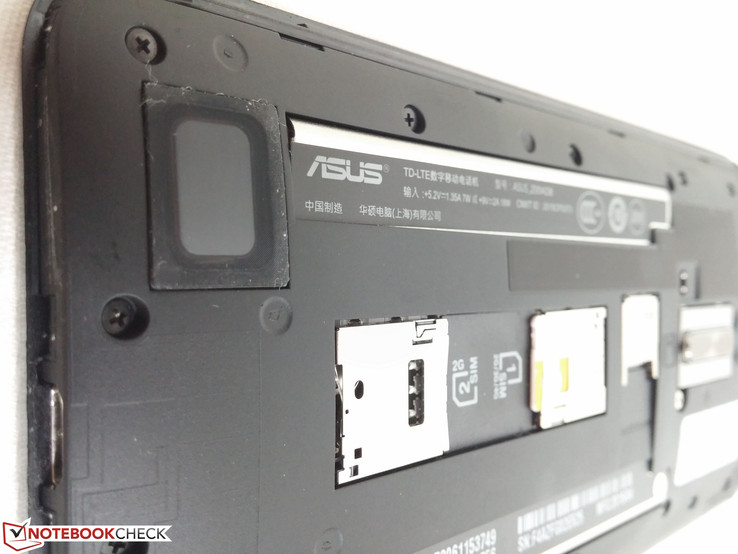
Battery Life
The 11.4 Wh battery (3000 mAh) is essentially the same capacity as other 5.5-inch devices including the iPhone 6 Plus (11.1 Wh), LG Flex 2 (11.8 Wh), OnePlus One (11.8 Wh), and the Redmi Note 4G (11.8 Wh). Like the larger ZenFone 6 and smaller ZenFone 5, the battery here is non-removable.
Integrated batteries aren't a huge issue as long as there are long runtimes to make up for it. With the ZenFone 2, users can expect a bit over 6 hours of constant WLAN use on a brightness of 150 nits (~70 percent setting) according to our looping browser script. This is below average compared to the 900+ and 600+ minutes of the OnePlus One and G Flex 2, respectively, when under the same conditions. The ZenFone still dies out more quickly than competing models when sitting idle on the lowest display brightness and with Smart Saving battery mode engaged.
At worst, users can expect about 4 hours of heavy use on maximum brightness. This is notably longer than the the closest competitors, but it's also worth keeping in mind that the display of the ZenFone 2 is not the brightest of the bunch.
Charging time from near depletion to 100 percent will still take a little over 2.5 hours with the included 5.2 V AC adapter. The high-capacity 18 W BoostMaster charger is only included with the 2.3 GHz Atom Z3580 ZenFone 2 model.
| Asus Zenfone 2 ZE551ML | Apple iPhone 6 Plus | OnePlus One | LG G Flex 2 | Xiaomi Redmi Note 4G | |
|---|---|---|---|---|---|
| Battery Runtime | 10% | 58% | 17% | -22% | |
| Reader / Idle | 1019 | 1436 41% | 1568 54% | 1274 25% | 985 -3% |
| WiFi v1.3 | 375 | 963 157% | 641 71% | ||
| Load | 255 | 199 -22% | 160 -37% | 143 -44% | 152 -40% |
| WiFi | 777 | 1126 | 662 |
Pros
Cons
Verdict
For a $200 to $300 smartphone, the ZenFone 2 makes a strong case against more expensive 5.5-inch devices, especially from a design and performance standpoint. The device itself is physically quite large, though no less difficult to grip and use. It's tough not to like the arched metallic back and the 4 GB RAM should appease users who are hooked on frequently installing applications just to try them while improving device longevity. The 4G and dual-SIM support will also appeal to international users who prefer a more established brand like Asus instead of rising Chinese brands like Xiaomi or Huawei.
Caveats include a backlight that is notably weaker than on competing models and the below average battery life. Granted, 6 hours of constant WiFi use is probably sufficient for most users, but the lack of a removable battery doesn't help it, either. These few major downsides make the similarly-priced OnePlus One an easier recommendation for those who don't see any short-term or long-term benefits of 4 GB RAM.
Asus Zenfone 2 ZE551ML
-
06/02/2015 v4(old)
Allen Ngo


 Deutsch
Deutsch English
English Español
Español Français
Français Italiano
Italiano Nederlands
Nederlands Polski
Polski Português
Português Русский
Русский Türkçe
Türkçe Svenska
Svenska Chinese
Chinese Magyar
Magyar